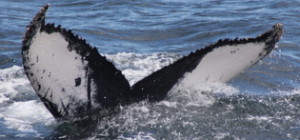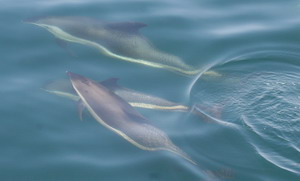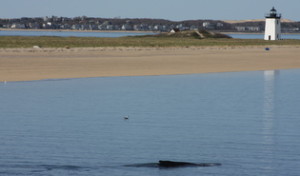Dolphin Fleet Naturalist Notebook April 24-30
April 24 was hazy with a brisk Northeasterly wind. We moved slowly into the Bay and eventually towards Race Point. Although the visibility was excellent, it was immediately obvious that few birds were in the area- and fewer whales. During the morning whale watch we sighted 7 humpback whales, all on long dives of at least 10 -20 minutes. The humpbacks were juveniles, a common occurrence in the spring. Only one was identified as a whale first sighted in 2009 and about to be named.

By afternoon our search time increased and finally we spotted a finback whale and 2 small humpbacks. The humpbacks continued their long dives but we were able to get a spectacular view of the sleek finback whale in the calm seas. On the sunset watch we traveled further west hoping to find more whales. We first saw small groups of harbor porpoise and dolphins, with the porpoise almost floating on the surface ands a North Atlantic right whale in the distance.

Although we spotted 4 humpbacks and 3 finback whales, they were on dives in some instances exceeding 20 minutes! Finally, one of the small humpback whales, first sighted last year, surfaced nearby and we were able to watch it travel just beneath the surface, fluke and dive.

April 25 was gray but the seas were relatively calm as we made our way around Long Point to Race Point and beyond. Long Point, the very last tip of land in Massachusetts and the fingertips of Cape Cod. The Long Point lighthouse has illuminated the entrance to Provincetown Harbor since the early 1800’s. The first light, built in 1826, consisted of a tower and lantern room from the roof of the keeper’s house. Its white light was visible for 13 nautical miles. The lamp was replaced with a lens in 1856, just before the building of 2 Civil war forts in anticipation of a rebel blockade of the bustling harbor. As the war progressed with no evidence of attack, the fortifications became known as Fort Useless and Fort Ridiculous and are so named in history books. From 1818 until about 1860 a community of fishermen and families established a salt works on Long Point. In the late 1840’s, over 200 people resided there and over 60 children attended a schoolhouse built on the point. By 1861only 2 houses and the school remained; many of the houses were floated over on scows to what we now call the west end. Today, the lighthouse has no keeper, solar panels have replaced the lenses and its bright green light remains an active navigational aid. The Bay that only a few days ago seemed to be teeming with whales was quiet- few birds and fewer whales. We traveled into the North Atlantic and after a long search found one humpback and one finback whale. The humpback whale was a juvenile first sighted in 2009.

No trips on April 26 due to high winds.
April 27 was overcast with cool Northeasterly winds and an offshore swell. We traveled throughout the Bay and North to Race Point. Our first sightings were of harbor porpoise and a small harbor seal. We also found 3 juvenile humpback whales, one sighted first in 2009 and 2 unknowns. As we entered the harbor we saw several cormorants and eider ducks. Eider ducks spend almost all of their life in the water, feed primarily during the day, and at low tide, avoiding strong winds and large waves in Provincetown’s protected harbor. They can dive between 35 and 60 feet below the surface and use their wings to swim under water feeding on mollusks, crustaceans, mussels, clams, starfish, sea urchins and other small marine life. The common eider’s color pattern is the reverse of most aquatic birds – the males have black bellies with white backs. It seemed as if there were more birds in the harbor than in the Bay! Perhaps they too have moved offshore for food.
No trips on April 28 due to high winds.
No trips on April 29 due to high winds.
April 30 was bright with westerly winds decreasing by afternoon. We found 3 species of marine mammals on our morning watch: harbor seals, finback whales and humpback whales. One of the humpback whales was sighted first last year and is about to be named. The whale will be named after the striking pattern on its ventral (underside) surface. We saw the same small humpback on the afternoon whale watch along with a large finback whale. It is time to begin to venture offshore and search for the whales that were so abundant in the Bay only a week ago!






